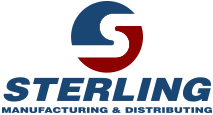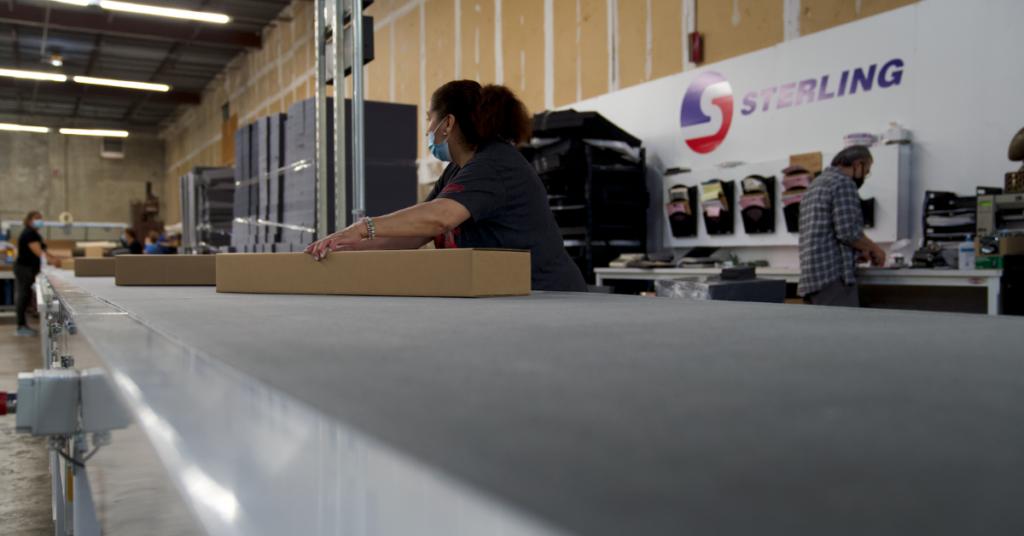Whether you’re a family operation fulfilling customer orders from your home office or an established brand with its own warehouse and crew, efficiency matters. Regardless of scale, sending your customer’s orders out the door correctly and safely takes time, resources, and labor. Finding ways to reduce any of those means the potential to fulfill more orders with less or increase your overall throughput without having to expand operations.
At Sterling, in addition to our robust manufacturing capabilities, we also specialize in kitting and fulfillment work for dozens of our customers. Today, we wanted to share a few best practices to help you get more efficiency out of your team, and potentially iron out a few common pain points.
Make Your Labels Work For Your Team
Between ensuring your packaging has all the markings and labels to satisfy your 3PL and represents your brand well, it’s easy to forget the needs of another group: your fulfillment team! So stop and ask yourself, do you suffer regular issues of customers receiving the wrong item (perhaps the wrong size or colorway)? Does verifying your pick lists seem to catch a lot of errors or take a long time?
These and other inefficiencies could be pointing to tags, labels, and order forms that are hard for your fulfillment team to parse. It could be something as simple as upping the print size on your pull list, or consolidating all the product information your team needs to reference to a single tag.
Even if these issues aren’t resulting in a significant number of errors, consider how much time it takes for the average member of your team to gather and verify these details. Shaving off even a few seconds per order could make an exponential improvement to your daily volume.
On the note of small changes adding up, take a look at the physical process of marking and labeling your items and orders. Is there a sticker that your team regularly spends 10+ seconds trying to free from its backing paper? Are there several tags or labels that could be easily consolidated into one? Even if this meant investing in a custom print job, the time and material savings may surprise you.
Focus on What’s Common
For the majority of businesses, their orders fall into the 80/20 rule. That is to say, 20% of their product catalog makes up 80% of their orders. If this describes your warehouse, is your inventory set up to make pulling those products faster?
To illustrate what we mean, let’s imagine a company that sells collectible enamel pins, which are stored in neatly organized and well labeled bins sorted alphabetically. This system is perfect for finding any pin, assuming all one-hundred designs are ordered in relatively equal amounts. But what if they have 5 pins that out-sell the others by a huge margin? In this situation, it might be better to have a second set of bins that are much nearer to the assembly line and contain only those five pins. Although this creates a slightly more complex organization system, it means a dramatic reduction in pick and pull times for the vast majority of their orders.
This specific example might not apply to you at all, but the principle holds true: It’s better to have a process that makes your most common orders easy to fulfill than one that caters to every possible outlier.
Invest In Your Warehouse Layout
One of the most common issues that undermines a growing fulfillment center is scope creep. That is to say, the way you had your products stored and slotted made good sense when you only had 5 SKUs, but now that your product catalogue has ballooned, pulling orders is a lot more chaotic.
The two most common reasons growing warehouses will give for putting this problem off is either they don’t want to invest in the time and hardware it would take to make improvements, or their team is very used to the current layout. Plus, fixing either means more shifts and/or downtime.
While both of these concerns are understandable, they’re selling today to pay for tomorrow. Organization and layout problems in a fulfillment center never improve on their own. At best, they will require unnecessary labor and hardware to overcome. At worst, they could result in outright failure as your fulfillment needs continue to grow.
The problems that are only slightly painful at 25 SKUs may bring operations to a grinding halt when you finally hit 50. So whether it takes a nasty invoice for new shelving, or bringing in a Saturday shift to get things reorganized, you’ll thank yourself for doing it down the line!
Balance Touches vs Material Costs
Similar to issues with warehouse organization and layout, we see a lot of “robbing Peter to pay Paul” when it comes to the cost of fulfillment materials. To use a fictional example, let’s say you’re a company that sells glassware. You wrap your goods in copious layers of bubble wrap and tape to keep them safe during shipment. You’ve gone with this method because you priced out a custom, die-cut polyurethane ship filler, and the difference in material cost was eye-watering.
The bubble wrap and tape may cost a lot less per order, but how much time does it take your fulfillment team to adequately cover each item? If that step was simplified to dropping in a filler and placing the items in the cutouts, how many more orders could you get out the door every single hour? Could you completely eliminate a fulfillment station and put those team members to work on something else?
Finding accurate answers to these questions takes time and research, but fulfillment is a game played in seconds and won in hours!
Make Improvement a Continuous Process
All of the tips we’ve provided are not-one time solutions. If they help you make a big improvement this week, you may need to re-apply them all over again three months from now when your business has grown or changed. That’s why the most important thing you can do to help your fulfillment become more efficient is to always be measuring your performance.
Take advantage of the analytics that your WMS provides. Ask your questions what’s frustrating about the way you currently do things. Maintain the mindset that, no matter how well you’re doing, there’s always room for improvement. The world of logistics never stops changing, so neither should you.


